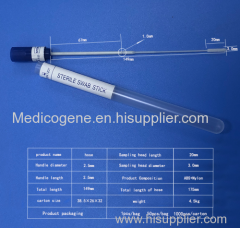


The difference between nasal swab and throat swab
| Place of Origin: | Guangdong |
|---|
Company Profile
| Location: | Shenzhen, Guangdong, China (Mainland) |
|---|---|
| Business Type: | Manufacturer |
Product Detail
| Brand Name: | Medico |
|---|
Product Description
The difference between nasal swab and throat swab
The results of the new coronavirus test are an important reference for the diagnosis and efficacy evaluation of the new coronavirus pneumonia. coronavirus test screening samples are mostly derived from deep cough sputum or throat swabs, and throat swabs are divided into nasopharyngeal swabs and oropharyngeal swabs . So, what is the difference between the two?
The pharynx includes the nasopharynx, oropharynx, and laryngopharynx. The mucous membranes of the three are continuous and belong to the upper respiratory tract. Nasopharyngeal swabs and oropharyngeal swabs only have different sampling paths. Oral sampling is an oropharyngeal swab, and nasal sampling is a nasopharyngeal swab.
Since the oropharyngeal swab can be operated by opening the mouth, it is relatively simple, so it is more commonly used clinically. However, the risk of exposure is higher for those who take the oropharyngeal sample. The operator often needs to face the patient's mouth. During the collection process, the patient is prone to symptoms such as irritating dry cough and vomiting, exposing the collector to the virus-carrying aerosol.
Nasopharyngeal swabs have several advantages over oropharyngeal swabs. It is possible to stay in the pharynx for a longer period of time during sampling, in order to obtain a sufficient amount of specimens, which is why the positive rate is higher than that of oropharyngeal swabs reported in the literature.
In addition, the patient is well tolerated, usually surface anesthesia and contraction of the nasal mucosa can be performed first, and a skilled sampler can sample the patient without anesthesia.
Since the operator can stand behind the patient when sampling the nasopharynx, the patient pulls down the mask to expose only the nostrils and cover the oral cavity. There is no need to look directly at the patient's oral cavity, and there is basically no pharyngeal reflex, so the exposure risk is quite lower. Individual patients may have a sneeze reflex after sampling, or they can be immediately covered with elbows or tissues.
If the collection of throat swab coronavirus test specimens is not standardized, it may cause "false negative" results and delay treatment for patients.
So, what is the key to the collection of throat swab coronavirus test specimens? According to Deputy Chief Physician Tian Peng, whether collecting nasopharyngeal swabs or oropharyngeal swabs, the depth of collection and the length of contact with mucous membranes are the key. If the nasopharyngeal swab is not collected deep into the nasopharyngeal cavity, the patient's vomiting response is too large when the oropharyngeal swab is collected and the sampling time is not enough. At this time, most of the cells collected are virus-free cells. May cause "false negative" coronavirus testing.
Some patients "re-yang" after a negative coronavirus test is sometimes related to inaccurate sampling.


